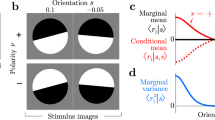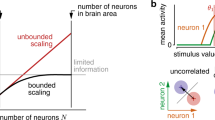Abstract
IT has been suggested1–3 that the first steps in visual processing strive to compress as much information as possible about the outside world into the limited dynamic range of the visual channels. Here I compare measured neural images with theoretical calculations based on maximizing information, taking into account the statistical structure of natural images. Neural images were obtained by scanning an image while recording from a second-order neuron in the fly visual system. Over a 5.5-log-units-wide range of mean intensities, experiment and theory correspond well. At high mean intensities, redundancy in the image is reduced by spatial and temporal antagonism. At low mean intensities, spatial and temporal low-pass filtering combat noise and increase signal reliability.
This is a preview of subscription content, access via your institution
Access options
Subscribe to this journal
Receive 51 print issues and online access
$199.00 per year
only $3.90 per issue
Buy this article
- Purchase on Springer Link
- Instant access to full article PDF
Prices may be subject to local taxes which are calculated during checkout
Similar content being viewed by others
References
Barlow, H. B. in Sensory Communication (ed. Rosenblith, W. A) 217–234 (MIT Press, Cambridge, MA, 1961).
Srinivasan, M. V., Laughlin, S. B. & Dubs, A. Proc. R. Soc. Lond. B216, 427–459 (1982).
Laughlin, S. B. Trends Neurosci. 10, 478–483 (1987).
Kretzmer, E. R. Bell Lab. Record Nov., 401–404 (1954).
Atick, J. J. & Redlich, A. N. Neural Comput. 2, 308–320 (1990).
Kretzmer, E. R. Bell Syst. tech. J. 31, 751–763 (1952).
van Hateren, J. H. J. comp. Physiol. A 171, 157–170 (1992).
Tsukamoto, Y., Smith, R. G. & Sterling, P. Proc. natn. Acad. Sci. U.S.A. 87, 1860–1864 (1990).
Goldman, S. Information Theory (Dover, New York, 1953).
Atick, J. J. Network 3, 213–251 (1992).
Laughlin, S. B. in Physical and Biological Processing of Images (eds Braddick, O. J. & Sleigh, A. C.) 42–53 (Springer, Berlin, 1983).
Burton, G. J. & Moorhead, I. R. Appl. Opt 26, 157–170 (1987).
Field, D. J. J. opt. Soc. Am. A4, 2379–2394 (1987).
Laughlin, S. B. & Hardie, R. C. J. comp. Physiol. 128, 319–340 (1978).
Author information
Authors and Affiliations
Rights and permissions
About this article
Cite this article
van Hateren, J. Real and optimal neural images in early vision. Nature 360, 68–70 (1992). https://doi.org/10.1038/360068a0
Received:
Accepted:
Issue Date:
DOI: https://doi.org/10.1038/360068a0
This article is cited by
-
A higher order visual neuron tuned to the spatial amplitude spectra of natural scenes
Nature Communications (2015)
-
Decorrelation and efficient coding by retinal ganglion cells
Nature Neuroscience (2012)
-
Propagation of photon noise and information transfer in visual motion detection
Journal of Computational Neuroscience (2006)
-
Dynamic predictive coding by the retina
Nature (2005)
Comments
By submitting a comment you agree to abide by our Terms and Community Guidelines. If you find something abusive or that does not comply with our terms or guidelines please flag it as inappropriate.



